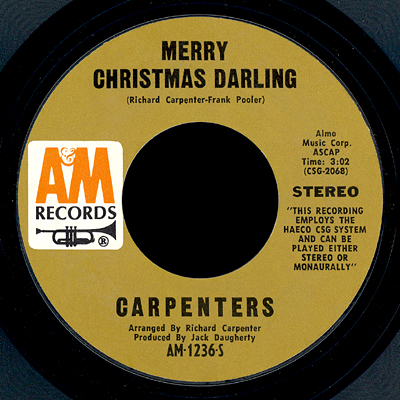Rick-An Ordinary Fool
Well-Known Member
What exactly is HAECO CSG Processing and why was it used on certain Carpenters 45's? Why do some have it marked on the label & others don't? Some have it on both side & some don't. Even though some of the labels don't have it listed you can still tell it has this processing by looking at the 45 closely in the light.
I have found this Processing on the following 45's:
It's on the Calling Occupants (Edited Version 3:59) On Promo 45 Only, The other side is the longer version of Calling Occupants & does not have this Haeco processing.
It's on the Promo of Santa Claus Is Coming To Town on the Stereo Side only, The other side is Mono & does not have this Haeco Processing.
It's on the Merry Christmas Darling #1236-S has the Haeco processing & the flip side is Mr Guder and also has the processing.
Are there other Carpenters 45's that have this Haeco Processing too?
I have to admit that it is wild to hear these w/ headphones on, it's like the sound is coming from all around. What I also noticed while listening to these w this processing is they seem louder to me than the non ones, especially of Santa Clause & Calling Occupants ones. Also on the Calling Occupants Haeco side, when the electric piano starts, it's like jumping from ear to ear & bouncing around, it's really wild w/ my headphones on
I have found this Processing on the following 45's:
It's on the Calling Occupants (Edited Version 3:59) On Promo 45 Only, The other side is the longer version of Calling Occupants & does not have this Haeco processing.
It's on the Promo of Santa Claus Is Coming To Town on the Stereo Side only, The other side is Mono & does not have this Haeco Processing.
It's on the Merry Christmas Darling #1236-S has the Haeco processing & the flip side is Mr Guder and also has the processing.
Are there other Carpenters 45's that have this Haeco Processing too?
I have to admit that it is wild to hear these w/ headphones on, it's like the sound is coming from all around. What I also noticed while listening to these w this processing is they seem louder to me than the non ones, especially of Santa Clause & Calling Occupants ones. Also on the Calling Occupants Haeco side, when the electric piano starts, it's like jumping from ear to ear & bouncing around, it's really wild w/ my headphones on



